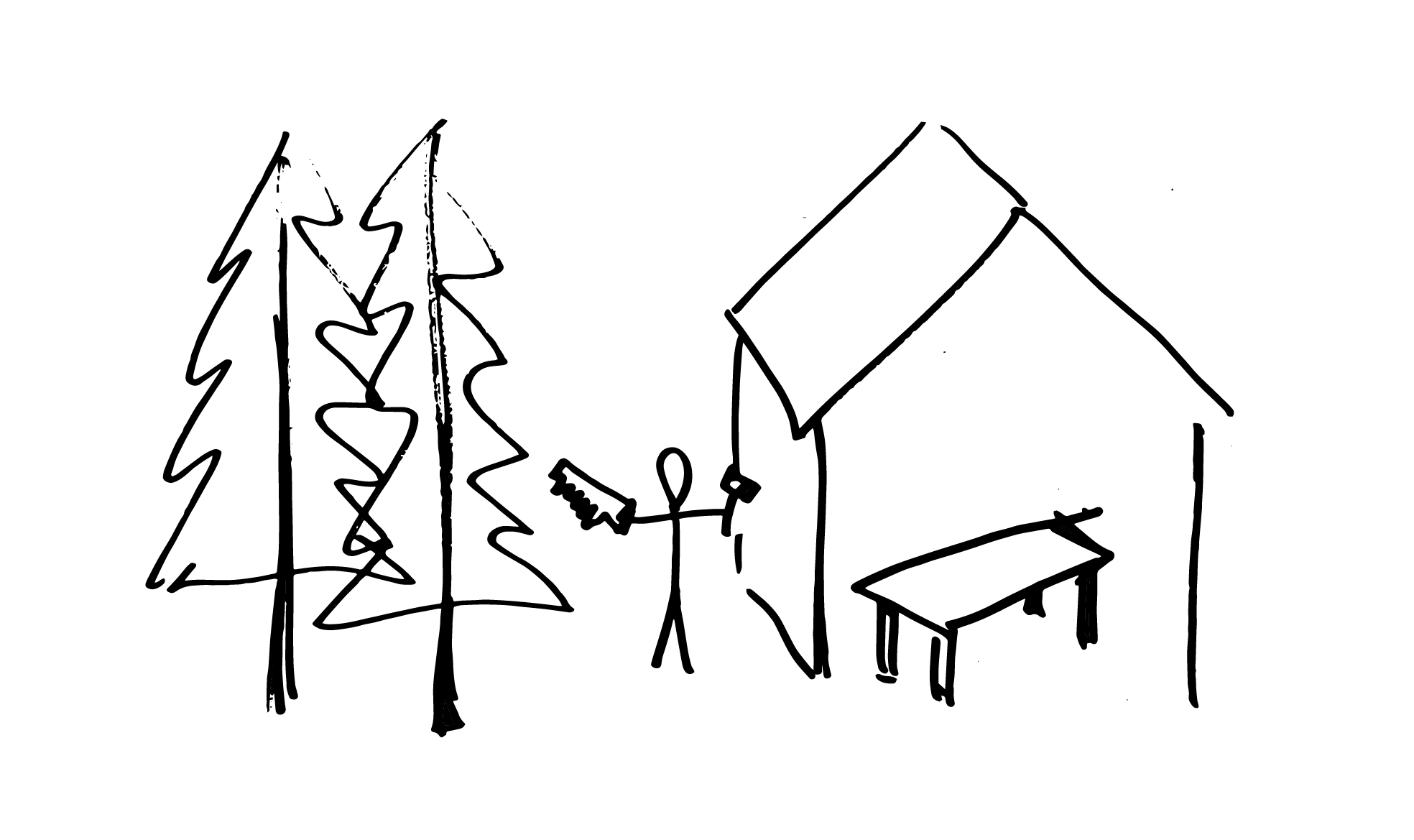May 8, 2022
TIMBER [ˈtɪmbə(r)]: trees that are grown to be used in building or for making things
PLAUSCH [plaʊ̯ʃ]: german expression for ‘social gathering’ or ‘cheerful chat’
An interview series to unravel the essence of the IntCDC projects, meet the researchers behind these projects and understand their work routines and passion for wood.
 For our second interview as part of the timber plausch series, we got the chance to chat with Oliver Bucklin. Oliver is part of the Cluster of Excellence – Integrative Design and Construction for Architecture (IntCDC) at the University of Stuttgart. His work revolves around mono-material solid-timber construction (AP 15). During a visit to the digitize wood office, he surprised us with his skills in using the balance board.
For our second interview as part of the timber plausch series, we got the chance to chat with Oliver Bucklin. Oliver is part of the Cluster of Excellence – Integrative Design and Construction for Architecture (IntCDC) at the University of Stuttgart. His work revolves around mono-material solid-timber construction (AP 15). During a visit to the digitize wood office, he surprised us with his skills in using the balance board.
digitize wood: Oliver, to start with: How would you explain your work to a kid or your grandparents?
Oliver: We already have a tagline for the project, which is "the log cabin for the 21st century". I think that describes it well in a single line. Otherwise, I would say that we use robots of various types to make log cabin type constructions be more energy-efficient and be more 'industrialized' for current construction techniques.
digitize wood: So, what would you say is the environmental benefit of your research, if you could summarize it in a few sentences?
Oliver: We are hoping to develop a facade system that uses a single renewable material that can capture atmospheric carbon storage in a physical solid form to generate a building envelope that performs better than the equivalent ‘vernacular style’. If you look at a log cabin, they are similar in the sense that you take logs and make a building envelope, but they don't perform well. They're leaky, so lots of air permeation, and they don't insulate well.
If you want to achieve contemporary building standard performance with something like that, you need to add layers of foam insulation. You need to add paper barriers. You have to tape everything, put silicon in the joints. So, we're trying to replace all of these extra materials with an intelligent joint system that can achieve the same performance.
digitize wood: And for how long have you been working on this? It's been some years now, right?
Oliver: Yes, it will be six years this July!
digitize wood: And what exactly is it that gets you jumping out of bed and excited to go to work every day?
Oliver: Oh, there are many things I love about it, I could just write down a whole bunch of things! I love working with wood. Whether it's small furniture for the apartment, large-scale multifamily housing, or office buildings. I love the different aspects of it, the design, and the development process. It's about developing a system, coming up with ideas, and then testing them in a rigorous scientific method. One of my favourite things is developing tools and software, I really like this challenge.
I also enjoy working with experts in the field. At the University we have partners at the Institute for Machine Tools or the Institute for Acoustics and Building Physics for example. It’s always great to work with people who know more about all of these things. And I simply love the work culture at ICD [Institute for Computational Design and Construction at the University of Stuttgart] and the interaction with students. Although it's been much more reduced recently, I do enjoy the interactions with students a lot, whether it's teaching or tutoring a master's thesis. Or grab a drink after work [laughs].
digitize wood: For us, it seems there's not a typical day in your routine. What did last week look like for you for example?
Oliver: Currently, I'm trying to develop tools and scripts so that in a couple of weeks, I can take a wall sample and produce the fabrication curve that one would use to plug into digital fabrication. And this week I will be sitting in front of the computer writing C-sharp [progamming language]. The week before, I was building prototypes, which meant sawing by hand, chiselling to make details. Then a couple of weeks before that, I was running the robots to fabricate standard profile sections. And then every Tuesday I'll be teaching and working with students.
digitize wood: It looks like your days at IntCDC are very diverse!
Oliver: There is no typical day! [laughs] And that's another thing I love about the job because there's always something different, so much variety I get to do.
digitize wood: We saw that you were involved in both, the IBA timber prototype house and the 2019 ITECH demonstrator. The first was more about using wood as the same material for structure and thermal insulation. The other focuses on kinetic behaviour, actuation, carbon fibre, and other non-timber materials. We are wondering whether you see both worlds colliding in the future, do you still see them as two separate worlds? Or could the future be comprised of buildings made out of wood, but with integrative interactive control systems, integrated sensors?
Oliver: Buildings are very complex systems, there's always room for those types of systems to come together. However, both the timber prototype house and the current AP 15 research project are all about just using wood. We want to avoid using glue, avoid using nails and screws. That excludes any sort of embedded carbon fibre, electronic intelligence system. We want to put all of the intelligence in the planning and the fabrication so that the building envelope itself is as monolithic and mono-material as possible.
For my current work, the middle ground could be to bring in the interactive embedded computation matter at the fabrication level rather than at the building level. There's obviously room for that, but I don't have room for that right now [laughs].
digitize wood: And can you tell us more about the new prototype that you'll be developing from your research on highly insulated and recyclable solid timber construction? And how will it be differing from the IBA project?
Oliver: I think the biggest difference is that we want to do a multi-story facade instead of a complete building out of it. It will be focused on a panel-based system. In a lot of ways, it's more standardized and less expressive. We had this really cool road surface free-form geometry and now we're looking more at flat panels and how we can populate them on a standard CLT [cross-laminated timber] facade. That means we're working on construction details that integrate with standard industrial systems. In addition to that, there's more focus on accelerating production. For the production of the IBA house, each beam took 30 minutes, and at the end of the day, that's just not economically feasible for any large-scale construction. We're looking at how we can just shove beams through a machine and capture its profiles more efficiently.
digitize wood: Thank you for all the insights! Now, we are curious, if you could switch your research project with another person at the cluster which one would it be and why?
Oliver: That's the easiest question! I would switch with Sam Leder. I was the tutor for his thesis project, which became his current research project. We have continued to some extent – in my free time – developing kinematic logic for those types of mobile robots for climbing, for assembly. And it would be really cool to have the support of his partners that he's working with. This is more of a hobby and side project right now. I think the cluster will eventually support producing robots and making things with them.
digitize wood: Oliver, we asked you, to sketch your personal relation to wood or your love for the material. Would you mind explaining what we can see?
Oliver: I am a builder, so I'm building furniture and houses. And this is me with my relationship to the forest, which is not just a saw, I love wilderness as well. Camping and hiking, biking and going in the mountains, or playing in the woods.

Oliver Appling Bucklin is a research associate and doctoral candidate at the Institute for Computational Design and Construction at the University of Stuttgart. Oliver holds a Master in Architecture from the Harvard Graduate School of Design, as well as a Bachelor of Fine Arts in Ceramics from the University of Washington. Experience at the Harvard Center for Green Buildings and Cities led to an interest in scientific approaches to architectural design. His current research investigates sustainable building practices leveraging advanced modelling and fabrication in solid wood building envelope systems. Further research covers embedded electronics and custom mechanics, including mobile robotics and integrating computational intelligence in industrial processes. He has had extensive experience in the United States in general construction and woodworking and is currently involved in the Performative Wood group at the ICD.
Curious? Here's a workshop report on Oliver's project!
Today’s timber plausch interviewers: Christelle El Feghali & Linda Heiß
We use cookies to ensure the proper functioning of our website. For an improved visit experience we use analysis products. These are used when you agree with 'Statistics'. Privacy statement